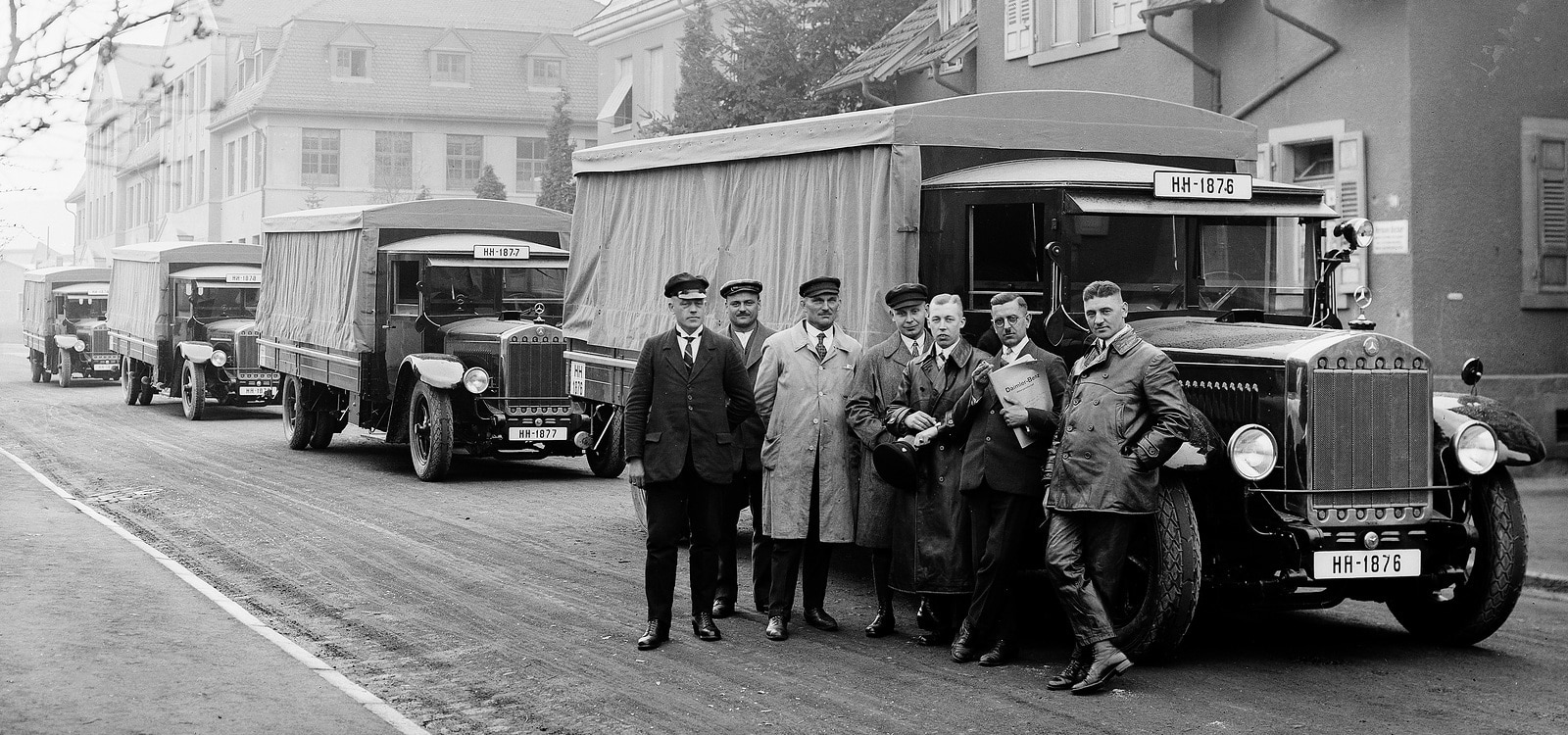When Daimler-Benz AG presented the first commercial vehicle range of the Mercedes-Benz brand at the German Motor Show in Berlin in October 1926, heavier vehicles were of course also on display alongside the L 1 light-duty trucks. One of them was a medium-sized truck for payloads of up to four tonnes. This was given the model designation L 2 and was a further development of the first prototype from 1925, which was initially designed for a lower payload.
The L 2 was powered by the M 26 in-line six-cylinder engine with an output of around 70 hp (51 kW). It was suspended from the upper part of the engine housing on the frame, which in turn was a riveted ladder-type frame with U-shaped main beams. A four-speed transmission with dry clutch was directly flange-mounted to the engine, which transmitted the power through an intermediate shaft with a disc joint to the universal joint arranged centrally in the frame. From there, a cardan shaft enclosed in a tube drove the spur gear hub drive of the wheels on the rear axle. This, like the front axle, was suspended from the frame on long semi-elliptical springs. The steering was a shock-free helical spindle steering system, which could be supplied as right-hand or left-hand steering according to customer requirements. The brake system consisted of internal shoe brakes on all four wheels with Bosch Dewandre power assistance. The hand brake, on the other hand, only acted on the rear wheels.
In addition to the L 2, there was also a low-frame version of the chassis with the model designation N 2, which was primarily intended for bus bodies. Technically, it did not differ from the high-frame model. Only the frame itself was clearly offset above the axles on the N 2, and the rear axle springs were arranged below the axle and not above it as on the L 2. For the N 2, the factory's own coachbuilding shop again offered various bodies for passenger transport, which could accommodate up to 35 people in the regular version. Special mention should be made at this point of the so-called high-seat bus body, an early form of stepped high-decker bus for long-distance travel. This could be supplied with either luxury seating for just 18 passengers or standard seating for 26 passengers, but only a few units were produced.
In addition to these standard models, the L 2 and N 2 were also available again from 1927 as special chassis for fire engines, which bore the model designations LS 2 and NS 2 in the case of the motorised fire engine chassis and the model designations LD 2 and ND 2 in the case of the turntable ladder chassis. For municipal applications, the L 2 and N 2 were available in a special version with a transfer case to drive pumps and tipping mechanisms of the bodies.
In 1929, a new M 36 F in-line six-cylinder engine with an output of 100 hp (74 kW) replaced the previous power unit. The following year, the OM 5 S diesel engine with 85 hp (63 kW) was also available as an additional engine option. However, the latter was initially only installed in the low-frame chassis of the N 2 and was mainly ordered by bus customers. In the course of 1930, the model nomenclature was changed so that the L 2 became the L 4000 and the N 2 the O 4000. The design engineers also took this opportunity to slightly revise both models technically. They now had a disc clutch. The O 4000 was also fitted with bigger 40x8" tyres instead of the 38x7" tyres previously used. This had become necessary primarily because of the diesel engine, in order to ensure sufficient ground clearance in all road situations for its significantly larger engine housing compared to the petrol engine.
While the L 4000 was dropped from the range in 1932, the O 4000 low-frame chassis remained in production, as large customers in particular, such as the German National Mail, continued to order large numbers of O 4000 buses from Daimler-Benz. From 1933, these were equipped with the new OM 67 diesel engine as the standard engine, which was replaced by the 110 hp (81 kW) OM 77 in 1935. In 1937, the O 4000 reached its final evolutionary stage with the OM 79 as its power source, before it was finally dropped from the range at the end of 1937.
Two special versions of the N 2 should not go unmentioned at this point. The first was created in 1931. In co-operation with the electrical engineering group Brown, Boveri & Cie. from Mannheim, BBC for short, the developers at Daimler-Benz AG created the so-called overhead wire omnibus on the basis of the N 2. It had a front-wheel drive chassis with a shortened wheelbase of 4600 mm, in which an electric motor arranged under the floor between the axles transmitted its power to the rear wheels via the familiar spur gear hub drive. The riveted all-steel body of the bus was supplied by the body plant in Sindelfingen. Even if the trolleybus remained a one-off, it provided those responsible with important findings that formed the basis for the development of other Mercedes-Benz trolleybuses.
The second special version of the N 2, or O 4000, on the other hand, dated from 1935. The Dresden fire brigade ordered six turntable ladders, nine motorised fire engines and three hose trucks from Daimler-Benz, all of which were based on the O 4000 chassis. This was unusual in that a successor model had long been available in the form of the Lo 3500 of the L 64 series. And the company also took an unusual approach to motorisation. Instead of an in-house engine, the fire engines were all powered by a Maybach twelve-cylinder petrol engine.
